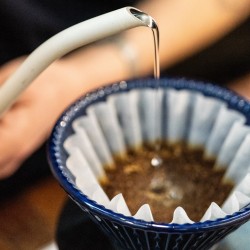You don’t need to be an expert to tell if you like a particular coffee or not, but establishing the vocabulary to describe flavours requires experience.
The Coffee Taster’s Flavour Wheel is developed by the SCAA (Specialty Coffee Association of America) and is an extremely practical tool to help us to define what is tasted. For your first time, identify the key flavours and then improve further.
For example:
• Sourness, bitterness, softness/sweetness, saltiness
• Then acidity, texture, aftertaste: Acidity: light, velvety, balanced, biting, bright, complex, intense, vinaceous, flat, tangy, dry, astringent, acid, syrupy, aggressive etc. Texture: Delicate, elegant, supple, structured, viscous, syrupy, thick, coated, watery, empty, grainy etc. Aftertaste: coarse, rough, neutral, pure, sustained, soft etc.
• Next, ask yourself about the aromas. Understand what is happening both on your tongue as well as in the back of the nasal passage.
Aromas, savours and flavours
Acidity: Desirable taste which is distinct and pleasant, but not sharp. The term “acidity” as used by coffee professionals evokes a bright and spirited coffee with respect to heavy, old, musty and bland notes.
Acrid: A burnt taste which is distinct, bitter or even irritating.
Bitterness: This concerns a distinct taste which is as unpleasant as it is strong, and sharp like quinine.
Animalic: This scent description is reminiscent of a smell characterised by wet fur, sweat, leather, animal hide or urine. This is not necessarily a negative attribute, but generally allows us to describe strong notes.
Astringent: Taste which evokes the impression of drying mucus membranes.
Burnt/smoked: This organoleptic description is reminiscent of the smell of burnt food. This is the smell which we associate with when we burn wood. This description is often used by tasters to indicate the degree of roasting for coffees which are heavily roasted, or oven-roasted coffees.
Caramelised: Taste reminiscent of crème brûlée; flavour of caramelised sugar.
Chemical: Chemical taste. May come from poorly maintained equipment, uncontrolled fermentation or coffee exposed to hydrocarbon fumes. Certain emulsions from the production of bags can also contribute to this problem.
Ashy: This mostly olfactory description is reminiscent of ash, smokers’ fingers or the smell produced when cleaning a chimney. This is not a negative attribute. In general, this description is used by tasters to indicate the degree of roasting.
Cereal/Malt/Toast This description encompasses aromas which are characteristic of cereals, malt and toast. It includes the aroma and savour of raw or roasted cereal grains (in particular roasted maize, barley or wheat), malt extract, the aroma and savour of fresh bread, and toast that has just been grilled.
Chocolaty: Reminiscent of the aroma and taste of cocoa powder and chocolate (especially black chocolate and milk chocolate). This is an aroma that is sometime qualified as soft.
Baked: Generally unpleasant taste. Indicates that the coffee has been over-roasted or roasted too slowly.
Twisty: The coffee doesn’t really lack sharpness, but may be lacking at a later stage.
Winey: Fruity taste reminiscent of fresh wine. Not necessarily unpleasant when it remains in the background.
Spicy: This organoleptic description is typical of the smell of sweet spices.
Balanced or round: Acidity and body are present in appropriate measure.
Bland or neutral: Taste without flavour, flat.
Fermented: Pronounced taste of fermentation usually due to late harvest or improper fermentation. Extremely unpleasant smell and taste. In its most present form we sometimes talk about a “hide” taste in reference to the smell of untreated animal pelts.
Floral: This aromatic description is reminiscent of the scent of flowers. It is associated with the light smell of different types of flowers, especially honeysuckle, jasmine and rose. Aroma which is usually subtle and not very intense.
Fruity: Coffees with fruity tartness.
Woody taste: More or less pronounced woody taste.
Grassy taste: Very distinct; can be markedly unpleasant.
Onion flavour: Approaching a putrid smell. Major flaw.
Rubbery: Rubbery smell and taste. Usually present in fresh Robusta.
Green, greenish: Denotes the smell of hay. Most common in early harvests. In certain coffees this flavour fades several weeks after drying. Rarely present in coffees which are entirely sun-dried. May also come from unripened cherries.
Baggy: Unwanted contamination similar to the smell of jute sacks. Often observed among coffees which have been stored too long in poor conditions. Woody: This aromatic description is reminiscent of the smell of dry wood, of an oak cask, dead wood or cardboard.
Unclean: Self-explanatory. Coffee with an undefined unclean taste.
Medicinal: This olfactory description is reminiscent of the smell of chemicals, medicines and those of the hospital. This expression is applied to coffees which give off odours such as that of Rio coffee, or coffees which are reminiscent of chemical residues, or coffees which are significantly flavoured and produce large quantities of volatile substances.
Musty or mouldy: Self-explanatory. Improper drying or storage or transport in an overly humid and unventilated area.
Natural: The natural characteristic is a full-bodied, typical coffee.
Neutral: No predominant characteristics. May make a good base for blends.
Nutty: This description of the aroma is reminiscent of the smell and savour of fresh nuts (distinct from rancid nuts) and not of bitter almonds.
Common: Rather mediocre beverage lacking tartness.
Pungent: A taste sensation of general bitterness for the brew. Burning or hot sensation.
Foul: Coffee with an unpleasant taste, often due to rotten pulp. Often the most advanced stage of fruity coffees with a sour taste. This is often due to poor preparation at the factory or the use of polluted water. Note that the presence of a single nipped bean during pulping, which is extremely discoloured, is enough to give the cup a bad taste and spoil an otherwise good coffee.
Peanut: Taste of peanut generally associated with unripened beans and/or underroasting.
Harsh: Taste coming from a coffee with a green appearance, immature; usually with a rough aftertaste. Bushes struck by a lack of or too much water produce a marbled bean often releasing this flavour.
Rio or Phenolic: Taste, smell and afternotes of medicine, slightly iodised along with phenol or carbolic notes.
Wild or animalic: Scent of leather which can be found in certain Ethiopian coffees.
Tainted: Term used to denote the presence of flavours which are strange for a good coffee, but which cannot be defined or placed in a specific category. Often used to describe a strange or particular taste in the absence of a precise definition. When it is possible to define the strange flavour, we then name it accordingly.
Sour, sourish: Unpleasant taste denoting the smell of decomposing pulp. Caused by improper preparation at the factory, poor fermentation causing the continuation of the process of fermentation in the initial stages of drying, the presence of beans which are too ripe and yellow, delayed drying causing heating of the coffee, or excessive fermentation with a lot of pulp. This is frequently caused by nipped beans during pulping, resulting in contamination.
Tobacco: This organoleptic description is reminiscent of the smell and taste of tobacco, but must not be used for burnt tobacco.
Earthy: Self-explanatory. Not to be confused with grassy. The body of coffee and its physical properties.
Acidic: A basic taste characterised by the presence of an organic acid. A pronounced taste, pleasant and agreeable, especially present in certain origins, as opposed to a sour or overfermented taste.
Astringent: This attribute is characterised by an aftertaste with the feeling of a dry mouth, which is undesirable for coffee.
Rough: Sensation of roughness in the mouth.
Crema: The crema obtained from the surface of the cup enables the quality of the coffee to be judged: a crema that is too thin or too clear reveals poor grinding (not fine enough), old coffee, weak pressing from the machine or water that is too cold. On the contrary, crema that is too dark reveals grinding that is too thin, water that is too hot or overroasting.
Soft: Good coffee, distinct without any roughness and notes characterised with fruit, chocolate and caramel. A flavour which is generally not very pronounced.
Well-rounded: Covers good characteristics such as body, tartness; similar to wine (powerful, with consistence and edge)
Light: Extremely full aroma with little harshness or tartness.
Thin: No body to the cup.
Mellow: Full and velvety taste which may be lacking tartness. Impression which is generally pleasant for the senses.
Sharp: Coffee with a delicate, sharp, acidic taste.
Rich: Very ample aroma with a well-rounded body.
Suave: Slightly acidic softness.
Cup: Colour of liquid obtained: very delicate, good, discreet, poor, heavy, coarse, suspicious.
Velvet: Coffee which has body but is low in acidity. Sensation of softness.
Bright: Biting sensation.
Winey: A rich coffee with a full body and the softness of a well-aged red wine, but with a persistent acidity. A major flaw when phenol notes are present.


